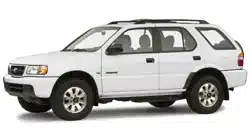
2001 Passport Online Reference Owner's Manual
Use these links (and links throughout this manual) to navigate through this reference.
For a printed owner's manual, click on authorized manuals or go to www.helminc.com.
Contents
Owner's Identification Form
A Word to the Owner
........................................................................................................................... i
Important Handling Information...................................................................................................... ii
A Few Words About Safety
................................................................................................................ iv
Driver and Passenger Safety .............................................................................................................. 3
Proper use and care of your vehicle's seat belts, and Supplemental Restraint System.
Off to a Good Start
............................................................................................................................. 49
Instruments and Controls
................................................................................................................. 55
Instrument panel indicator and gauge, and how to use dashboard and steering column controls.
Seats
.................................................................................................................................................... 89
Interior Features
............................................................................................................................... 99
Comfort and Convenience Features
.............................................................................................. 119
How to operate the climate control system, the audio system, and other convenience features.
Driving Tips
...................................................................................................................................... 155
The proper way to start the engine, shift the transmission, and park, what gasoline to use, how to
break -in your new vehicle, and how to load luggage and other cargo.
In Case of Emergency
...................................................................................................................... 183
This section covers several problems motorists sometimes experience, and how to handle them.
Care and Maintenance
.................................................................................................................... 195
The Maintenance Schedule shows you when you need to take your vehicle to the dealer and
tips on cleaning and protecting your vehicle. Things to look for if your car ever needs body
repairs.
Technical Data
................................................................................................................................. 231
ID numbers, dimensions, capacities, and technical information.
Owner Assistance
............................................................................................................................. 245
A summary of the warranties covering your new Honda, and how to contact us.
Authorized Manuals
........................................................................................................................ 253
How to order manuals and other technical literature.
Index
....................................................................................................................................................
I
Supplemental Restraint System
Off Road Driving Information
Loading ...
Loading ...
Loading ...
